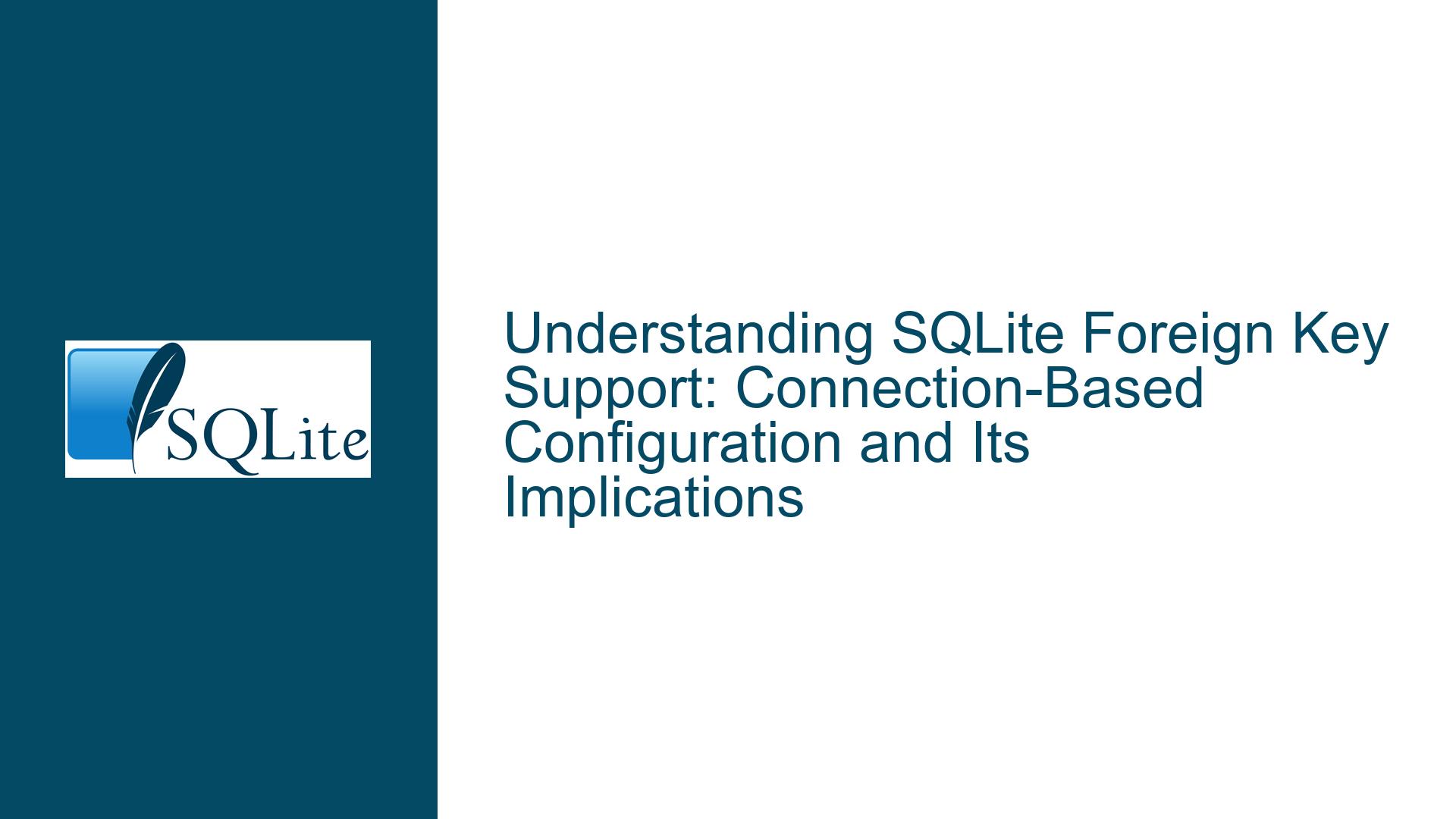SQLite Foreign Key Support: Connection-Based Configuration and Its Implications
SQLite Foreign Key Constraints: Connection-Level Configuration
SQLite is a lightweight, serverless, and self-contained database engine that is widely used in embedded systems, mobile applications, and small-scale projects. One of its features is the support for foreign key constraints, which enforce referential integrity between tables. However, unlike many other database systems, SQLite does not enable foreign key constraints by default. Instead, foreign key support must be explicitly enabled for each database connection using the PRAGMA foreign_keys = ON; command. This design choice has raised questions about why foreign key support is tied to the connection rather than being a property of the database file itself.
The connection-based configuration of foreign key support in SQLite is rooted in historical and technical considerations. When SQLite was initially designed, foreign key constraints were not part of the database engine. They were introduced later as an enhancement, and the decision to make them optional was driven by the need to maintain backward compatibility with existing applications and database files. This approach ensures that older applications, which were not designed to handle foreign key constraints, can continue to function without modification.
The connection-level configuration also provides flexibility in scenarios where foreign key enforcement is not desirable. For example, during bulk data operations or migrations, temporarily disabling foreign key checks can improve performance and simplify the process. However, this flexibility comes with the responsibility of ensuring that foreign key constraints are enabled when necessary to maintain data integrity.
Historical Evolution and Technical Constraints
The decision to implement foreign key support as a connection-level option in SQLite is influenced by several factors, including the historical evolution of the database engine and technical constraints related to the database file format.
When SQLite was first developed, the primary focus was on simplicity and minimalism. The database file format was designed to be straightforward, with a focus on storing data efficiently. At that time, foreign key constraints were not part of the SQL standard, and their inclusion in SQLite was not considered. As a result, the database file format did not include any provisions for storing metadata related to foreign key constraints.
When foreign key support was later added to SQLite, the developers faced the challenge of integrating this feature into the existing database file format without breaking compatibility with older versions of the database engine. Storing foreign key metadata in the database file would have required changes to the file format, which could have rendered existing database files incompatible with newer versions of SQLite. To avoid this issue, the developers chose to implement foreign key support as a connection-level option, which does not require any changes to the database file format.
Another consideration was the need to maintain backward compatibility with existing applications. Many applications that were developed before the introduction of foreign key support in SQLite were not designed to handle foreign key constraints. Enabling foreign key support by default could have caused these applications to fail or behave unexpectedly when encountering foreign key violations. By making foreign key support optional and requiring it to be explicitly enabled for each connection, SQLite ensures that older applications can continue to function without modification.
Performance Optimization and Bulk Data Operations
One of the key advantages of the connection-based configuration of foreign key support in SQLite is the flexibility it provides in terms of performance optimization and bulk data operations. In scenarios where large volumes of data need to be inserted, updated, or deleted, temporarily disabling foreign key checks can significantly improve performance.
Foreign key constraints introduce additional overhead because they require the database engine to perform checks to ensure that referential integrity is maintained. For example, when inserting a row into a child table, SQLite must verify that the corresponding row exists in the parent table. Similarly, when deleting a row from a parent table, SQLite must check that there are no dependent rows in the child table. These checks can slow down data operations, especially when dealing with large datasets.
In bulk data operations, such as data migrations or batch updates, the overhead of foreign key checks can be particularly burdensome. In such cases, temporarily disabling foreign key support can allow the operations to proceed more quickly. Once the bulk operations are complete, foreign key support can be re-enabled to ensure that data integrity is maintained.
For example, consider a scenario where a large dataset needs to be imported into a SQLite database. If foreign key support is enabled, each row inserted into the child table would trigger a check to ensure that the corresponding row exists in the parent table. This can result in a significant performance penalty. By temporarily disabling foreign key support during the import process, the data can be inserted more quickly. After the import is complete, foreign key support can be re-enabled, and any violations can be addressed.
Implementing PRAGMA journal_mode and Database Backup Strategies
To ensure data integrity and optimize performance when working with foreign key constraints in SQLite, it is important to implement appropriate strategies for database backup and journaling. SQLite provides several options for configuring the journaling mode, which affects how transactions are handled and how the database recovers from crashes or power failures.
The PRAGMA journal_mode command allows you to configure the journaling mode for the database. The available options include DELETE, TRUNCATE, PERSIST, MEMORY, WAL (Write-Ahead Logging), and OFF. Each mode has its own trade-offs in terms of performance, durability, and recovery capabilities.
For databases that rely on foreign key constraints, the WAL mode is often recommended. The WAL mode provides better concurrency and performance compared to the default DELETE mode, as it allows multiple readers and a single writer to access the database simultaneously. Additionally, the WAL mode provides better durability and recovery capabilities, which are important for maintaining data integrity in the event of a crash or power failure.
In addition to configuring the journaling mode, it is important to implement a robust database backup strategy. SQLite provides several methods for backing up databases, including the .backup command, the sqlite3_backup API, and the VACUUM INTO command. Each method has its own advantages and limitations, and the choice of method depends on the specific requirements of the application.
For example, the .backup command is a simple and effective way to create a backup of a SQLite database. It creates a copy of the database file while the database is in use, ensuring that the backup is consistent and up-to-date. The sqlite3_backup API provides more flexibility and control over the backup process, allowing you to perform incremental backups and resume interrupted backups. The VACUUM INTO command creates a new database file by rebuilding the entire database, which can be useful for optimizing the database file and removing unused space.
When implementing a backup strategy, it is important to consider the impact of foreign key constraints on the backup process. For example, if foreign key support is enabled during the backup, the backup process may be slower due to the additional checks performed by the database engine. In some cases, it may be beneficial to temporarily disable foreign key support during the backup process to improve performance. However, this should be done with caution, as it can affect the integrity of the backup.
Conclusion
The connection-based configuration of foreign key support in SQLite is a design choice that reflects the historical evolution of the database engine and the need to maintain backward compatibility with existing applications. While this approach provides flexibility in terms of performance optimization and bulk data operations, it also requires developers to be mindful of enabling foreign key support when necessary to maintain data integrity.
By understanding the reasons behind this design choice and implementing appropriate strategies for database backup and journaling, developers can effectively manage foreign key constraints in SQLite and ensure the integrity and performance of their databases. Whether you are working on a small-scale project or a large-scale application, the flexibility and simplicity of SQLite make it a powerful tool for managing relational data.






